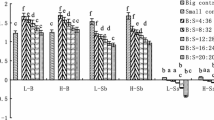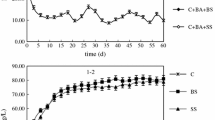Abstract
An integrated multi-trophic aquaculture (IMTA) system consisting of the ascidian Styela clava and the sea cucumber Apostichopus japonicus with microalgae was grown in a seawater mesocosm. Microbial populations in the water, sediment and shelters were monitored over time. The composition of the water microbial community in the IMTA system did not differ significantly from that of the traditional culture system without ascidians. Bacterial populations in the water, sediment and shelters were low in the traditional A. japonicus aquaculture system, and lower in the IMTA system. The number of Vibrios in the water, sediment and shelters in the IMTA system was significantly lower than in the traditional culture (p < 0.05), while the quantity of Bacillus was higher in the sediment and shelters. All of these results indicate that the IMTA system effectively inhibited the growth of harmful bacteria, an important positive function in the health of the culture. The bacterial diversity index in the water in the IMTA system was between those of the baited and non-baited traditional aquacultures and was slightly reduced in the shelters. Over time, the bacterial diversity index in the sediment gradually dropped, especially in summer and autumn, when it was significantly lower than in the traditional culture. In winter, the diversity index increased to some extent, approaching that of the traditional culture.

















Similar content being viewed by others
References
Balcázar JL, Natuschka ML, José P et al (2010) Phylogenetic characterization and in situ detection of bacterial communities associated with seahorses (Hippocampus guttulatus) in captivity. Syst Appl Microbiol 33(2):71–77
Bao J, Lihong C, Ronglian X, Aili J (2015) A new integrated multi-trophic aquaculture system consisting of Styela clava, microalgae, and Stichopus japonicus. Aquacul. Int. 23:471–497
Bosma RH, Verdegem MCJ (2011) Sustainable aquaculture in ponds: principles, practices and limits. Livest. Sci. 139(1–2):58–68
Burke DJ, Hamerlynck EP, Hahn D (2002) Interactions among plant species and microorganisms in saltmarsh sediments. Appl Environ Microbiol 68:1157–1164
Defoirdt T, Sorgeloos P, Bossier P (2011) Alternatives to antibiotics forthe control of bacterial disease in aquaculture. Curr Opin Microbiol 14:251–258
Demin Z, Xin W, Jinbo X, Jianlin Z et al (2014) Bacterioplankton assemblages as biological indicators of shrimp health status. Ecol Indic 38:218–224
Dong Y, Dong S, Ji T (2008) Effect of different thermal regimes on growth and physiological performance of the sea cucumber Apostichopus japonicus Selenka. Aquaculture 275:329–334
Espeland EM, Francoeur SN, Wetzel RG (2001) Influence of algal photosynthesis on biofilm bacterial production and associated glucosidase and xylosidase activities. Microb Ecol 42:524–530
Glibert PM, Burkholder JM (2011) Harmful algal blooms and eutrophication: “strategies” for nutrient uptake and growth outside the Redfield comfort zone. Chin J Ocean Limnol 29:724–738
Huirong L, Yubin F, Yun L, Weishang J et al (2001) Composition of marine bacteria in micro -biofilm formed on four different artificial substrata. J Ocean Univ Qingdao 31(3):401–406
Irisarri J, Fernández-Reiriz MJ, Labarta U et al (2015) Availability and utilization of waste fish feed by mussels Mytilus edulis in a commercial integrated multi-trophic aquaculture (IMTA) system: a multi-indicator assessment approach. Ecol Indic 48:673–686
Jiwen L, Hongmei Y, Meixun Z et al (2014) Spatial distribution patterns of benthic microbial communities along the Pearl Estuary, China. Syst Appl Microbiol 37(8):578–589
Kevin KS, Bartholomew WG, Peter WP (2011) Development of phytoplankton communities and common off-flavors in a biofloc technology system used for the culture of channel catfish (Ictalurus punctatus). Aquacult Eng 45(3):118–126
Konnerup D, Trang NTD, Brix H (2011) Treatment of fishpond water by recirculating horizontal and vertical flow constructed wetlands in the tropics. Aquaculture 313(1–4):57–64
Lucas R, Courties C, Herbland A et al (2010) Eutrophication in a tropical pond: understanding the bacterioplanktonand phytoplankton dynamics during a vibriosis outbreak using flow cytometricanalyses. Aquaculture 310:112–121
MacDonald BA, Robinson SMC, Barrington KA (2011) Feeding activity of mussels (Mytilus edulis) held in the field at an integrated multi-trophic aquaculture (IMTA) site (Salmo salar) and exposed to fish food in the laboratory. Aquaculture 314(1–4):244–251
Machado A, Magalhães C, Mucha AP et al (2012) Microbial communities within saltmarsh sediments: composition, abundance and pollution constraints. Estuar Coast Shelf Sci 99:145–152
Mangion P, Taddei D, Frouin P et al (2004) Feeding rate and impact of sediment reworking by two deposit feeders Holothuria leucospilota and Holothuria atra on a fringing reef (Reunion Island, Indian Ocean). In: Heinzeller T, Nebelsick JH (eds) Echinoderms: Munchen. Taylor & Francis Group, London
Manu T, Antti K, Jukka C et al (2011) Differences in bacterial community composition in Baltic Sea sediment in response to fish farming. Aquaculture 313(1–4):15–23
Megan K, Craig LB, John WL (2011) Consumption and digestion of suspended microbes by juvenile Pacific white shrimp Litopenaeus vannamei. Aquaculture 319(3–4):363–368
Michio K, Kengo K, Yasunori K et al (2003) Effects of deposit feeder Apostichopusjaponicus on algal bloom and organic matter contents of bottom sediments of the enclosed sea. Mar Pollut Bull 47:118–125
Nagasoe S, Shikata T, Yamasaki Y et al (2010) Effects of nutrients on growth of the red-tide dinoflagellate Gyrodinium instriatum Freudenthal et Lee and a possible link to blooms of this species. Hydrobiologia 651:225–238
Naoki K, Kotaro S, Toshiaki M et al (2009) Comparison of bacterial communities in fish farm sediments along an organic enrichment gradient. Aquaculture 287(1–2):107–113
Nobre AM, Robertson-Andersson D, Neori A et al (2010) Ecological–economic assessment of aquaculture options: comparison between abalone monoculture and integrated multi-trophic aquaculture of abalone and seaweeds. Aquaculture 306(1–4):116–126
Palmborg C, Nordgren A, Bääth E (1998) Multivariate modelling of soil microbial variables in forest soil contaminated by heavy metals using wet chemical analyses and pyrolysis GC/MS. Soil Biol Biochem 30:345–357
Paul BG, Vogl CR (2011) Impacts of shrimp farming in Bangladesh: challenges and alternatives. Ocean Coast Manage 54(3):201–211
Pereira C, Santos L, Silva AP et al (2015) Seasonal variation of bacterial communities in shellfish harvesting waters: preliminary study before applying phage therapy. Mar Pollut Bull 90(1–2):68–77
Piceno Y, Lovell C (2000) Stability in natural bacterial communities: I. Nutrient addition effects on rhizosphere diazotroph assemblage composition. Microb Ecol 39:32–40
Schumacher J, Dolch T, Reise K (2014) Transitions in sandflat biota since the 1930s: effects of sea-level rise, eutrophication and biological globalization in the tidal bay Konigshafen, northern Wadden Sea. Helgol Mar Res 68:289–298
Simon PG, Robin JS, David JF et al (2010) Bacterial community responses to increasing ammonia concentrations in model recirculating vertical flow saline biofilters. Ecol Eng 36(10):1485–1491
Sohel MSI, Ullah MH (2012) Ecohydrology: a framework for overcoming the environmental impacts of shrimp aquaculture on the coastal zone of Bangladesh. Ocean Coast Manage 63:67–78
Taeho K, Ho-Seop Y, Seungsik S et al (2014) Physical and biological evaluation of co-culture cage systems for grow-out of juvenile abalone, Haliotis discus hannai, with juvenile sea cucumber, Apostichopus japonicus (Selenka), with CFD analysis and indoor seawater tanks. Aquaculture (in press). Corrected Proof, Available online doi:10.1016/j.aquaculture.2014.07.001
Thompson FL, Iida T, Swings J (2004) Biodiversity of vibrios. Microbiol Mol Biol Rev 68:403–431
Thompson JR, Pacocha S, Pharino C et al (2005) Genotypic diversity within a natural coastal bacterioplankton population. Science 307:1311–1313
van Dam AA, Beveridge MCM, Azim ME et al (2002) The potential of fish production based on periphyton. Rev. Fish Biol Fish 12:1–31
Verdegem MCJ, Eding EH, Sereti V et al (2007) Release of dissolved organic matter by coastal diatoms. Limnol Oceanogr 52:798–807
Wetz MS, Wheeler PA (2007) Release of dissolved organic matter by coastal diatoms. Limnol Ocean 52:798–807
Xiaohong G, Qianqian Z, Xiaoli Z et al (2015) Marine fungal communities in water and surface sediment of a sea cucumber farming system: habitat-differentiated distribution and nutrients driving succession. Fungal Ecol 14:87–98
Yun L, Ju S, Weishang J et al (2001) Study on microflora of the biofilm on the adhesive substrate of larva. J Ocean Univ Qingdao 31(1):69–74
Zhaoxia Z, Caihuan K, Danqing F et al (2005) Influences of marine adhesive bacteria on settlement and metamorphosis of Styela conopus Savigny larvae. Acta Oceanol Sin 27(5):96–102 (in Chinese)
Zhibing J, Yibo L, Jingjing L et al (2012) Phytoplankton community distribution in relation to environmental parameters in three aquaculture systems in a Chinese subtropical eutrophic bay. Mar Ecol Prog 446:73–89
Acknowledgments
This study was funded by the National Natural Science Foundation of China (Nos. 31070368, 31572622) and the National Natural Science Foundation of Shandong Province (BS2010HZ022, ZR2014CM031).
Author information
Authors and Affiliations
Corresponding author
Rights and permissions
About this article
Cite this article
Lin, J., Ju, B., Yao, Y. et al. Microbial community in a multi-trophic aquaculture system of Apostichopus japonicus, Styela clava and microalgae. Aquacult Int 24, 1119–1140 (2016). https://doi.org/10.1007/s10499-016-9975-2
Received:
Accepted:
Published:
Issue Date:
DOI: https://doi.org/10.1007/s10499-016-9975-2




